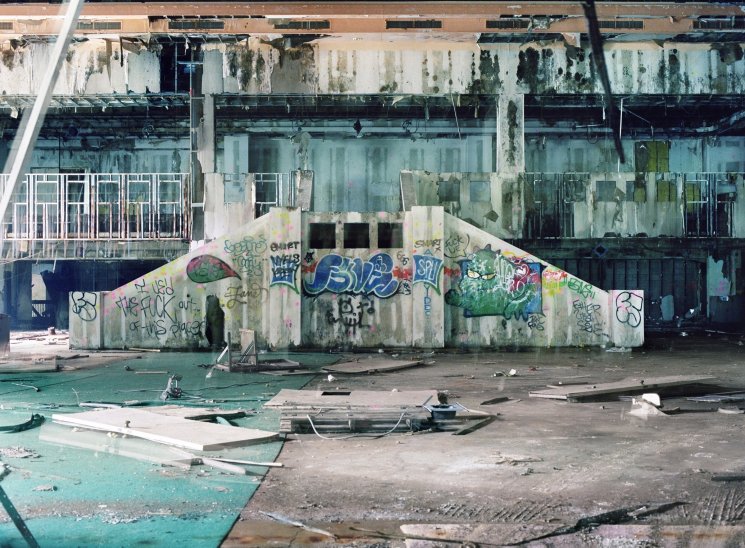Had photographer Marisa Scheinfeld, 33, been born a few decades earlier, she would have grown up in the heart of America's quintessential vacationland rather than its modern-day ruins. When Scheinfeld was 6 years old, her family left New York City to move upstate, to a tiny slice of the Catskills called Kiamesha Lake. "It's barely anything," she says of the leafy hamlet, but from the 1920s through the 1960s, millions of Americans—including Scheinfeld's father and grandparents—sought out the area's nearly 600 hotels, 500 bungalow colonies and 1,000 rooming houses for a dose of relaxation, nature and indulgence. It was the American Dream meets Disney World meets a summer camp for adults.
Dotted across Sullivan and Ulster counties, hotels like the Concord, Grossinger's, the Pines and the Laurels boasted luxury at its most grandiose. The Concord had 40 tennis courts, three golf courses, 1,200 guest rooms, a dining room for 3,000 and its own gas station. Nearby, Grossinger's was a rival behemoth, complete with the requisite outdoor activities and enormous interiors, plus a private post office and a landing strip. Wilt Chamberlain, who spent a summer working as a bellhop at Kutsher's Country Club, played on its basketball team. His coach: Red Auerbach. Muhammad Ali and Floyd Patterson trained for fights at the Concord. Evenings were just as dazzling. Everyone from Jerry Lewis to Rodney Dangerfield and Jerry Seinfeld performed their stand-up acts on hotel stages. Bungalow colonies offered a simpler side of the Catskills experience.
In the early decades of its heyday, the Catskills were a potent and affordable draw for Jews seeking to escape the suffocating heat, grating work conditions and anti-Semitism they endured in New York City. (Thus the area's nicknames, the Borscht Belt and the Jewish Alps.) Over time, the clientele diversified and, simultaneously, as American Jews assimilated, mainstream America soaked up Jewish culture, its artists, its comedians, its food.
"It all seems to be ending. You think kids want to come with their parents and take foxtrot lessons? Trips to Europe, that's what the kids want. Twenty-two countries in three days. It feels like it's all slipping away," says fictional Catskills resort owner Max Kellerman in the 1987 film Dirty Dancing. The movie, set during the summer of 1963, captured the region at the start of its gradual decline. Air conditioning and the rise of suburbia made summers at home easier to stomach. The thriving airline industry opened up exciting new vacation destinations. American Jews no longer needed a place all their own. And as the big hotel chains grew, they took business away from small hotels, bungalow colonies and local economies.
Today, almost all of these great Catskills resorts have been abandoned, transformed or demolished. The Concord, where Scheinfeld spent her summers working as a lifeguard and playing cards and bingo with her grandparents, closed in 1998. Soon after, it was bulldozed—all of it: the tennis courts and swimming pools and skating rinks and night clubs and thousands of hotel rooms.
Some hotels and bungalow colonies became meditation retreats and rehabilitation centers. A handful are now home to Orthodox Jewish families from New York. There is even talk of casinos reinvigorating the area.
Yet so many of these hotels and bungalows have become ruins. Left for dead, they have been reclaimed by nature, altered by time and neglect, their buildings and grounds morphing into eerie, postapocalyptic graveyards.
The Catskills of Scheinfeld's childhood—economically depressed, rundown—became her muse. In 2009, she left the East Coast to pursue her MFA at San Diego State University. Homesick, she spent her vacations in upstate New York; when a professor told her, "shoot what you know," she started photographing the ruins of these once-great hotels.
Her first museum exhibit, "Echos of the Borscht Belt: Contemporary Photographs by Marisa Scheinfeld," takes us claustrophobically close to the skeletal remains of the Catskills' golden age. The show, which officially opens September 10 at the Yeshiva University Museum in New York City, is haunted by the detritus of what once was: the missing people, the abandoned activities, the desolate places that at one time buzzed with life. Hallways are bruised and broken, strewn with crumbling plaster and fallen insulation. Wires hang from ceilings, graffiti covers the walls, moss grows over floors and up stairs. In a guestroom at the Tamarack Lodge, a pale pink rotary phone sits on a bare mattress, the receiver off the hook. And yet Scheinfeld's photography shows that these broken hotels are very much alive.
"While photographing a lot of these [hotels], I'd walk in and feel disturbed by the way they looked and their conditions. But I'd also be absorbed and amazed," she says. "There was a tragedy and awe going on at the same time."
The exhibit, which features 21 large-scale photos plus a few cases of Catskills ephemera (a Concord ski hat, Grossinger's stationery, postcards and room keys), takes you through the hotels as guests would have experienced them. We start at the entrances, all of them overgrown with lush trees and sunburnt fields, and then move into the once-ornate lobbies, pools and nightclubs, which now look more like where squatters, addicts and hipsters throwing DIY warehouse raves might congregate. A photo of Grossinger's indoor pool reveals a lone beach chair perched atop a layer of moss so thick it looks like a carpet. In another photo, small green plants push up through the sheet of ice covering the red-and-white tiled pool floor. Like soldiers at attention, they sprout from a puddle of soil and white goo.
Scheinfeld worked with local police and politicians to get permission to walk on the various properties. Sometimes, she simply trespassed. Once on-site, she often carefully stepped across crumbling foundations, sunken floors and broken glass. In the winter, snow often fell indoors, creating a layer of ice on what was left of the floors. By springtime, puddles were everywhere.
Scheinfeld wouldn't appreciate the reference, but it's impossible to look at her work without thinking of "ruin porn," a branch of photography that fetishizes decaying buildings, abandoned cities and the gorgeously twisted life left behind. There is ruin porn for theaters, Olympics sites, Chernobyl and an island in Japan. Photographer Andrew Moore captured the aftermath of Detroit's meteoric collapse. Robert Polidori did the same in New Orleans, post-Katrina.
Ruin porn has enticed both highbrow and lowbrow culture. Earlier this year, the Tate Britain debuted "Ruin Lust," which The Guardian called "a brilliant but bonkers exhibition." Ruin porn has found a home on Tumblr and Instagram, where everyone from photographers and middle schoolers to tourists and urban explorers delight in this newfound voyeurism-turned-"art." In July, Fast Company brought us "6 Scientific Reasons You Can't Stop Looking at Ruin Porn." In 2012, The New York Times published "How Detroit Became the World Capital of Staring at Abandoned Old Buildings" (which was a more sophisticated way of saying "How Detroit Became the World Capital of Ruin Porn"). The Atlantic sought to explain the psychology of ruin porn's popularity. That same year, the Huffington Post asked, "Is ruin porn good for tourism?"
Detractors argue that ruin porn glamorizes urban decay, turning real-life tragedies into spectacles. "I don't particularly like that phrase," says Scheinfeld. "Because the Catskills are so near and dear to my heart, I don't look at it like I'm exploiting it.… I proceed with a lot of respect for these spaces, because they are my hometown, and I did witness my hometown decline." She takes a breath, then adds, "I wish for it to be vibrant again, and in some way, I do want my work to call attention to the area and all its potential."
Next year, Cornell University Press will publish a book of Scheinfeld's photography, including 80 photos of hotel ruins; portraits of people who helped spark the Catskills heyday (including comedian Mal Z Lawrence and dancer Jackie Horner), and a collection of re-photographic works. The latter is especially compelling. Using vintage postcards as her guide, Scheinfeld hunted down the locations on the cards and took new photos from the very same perspectives and vantage points. One juxtaposition features the Laurel's indoor pool at its peak, packed with a crowd of smiling, tanned guests and tall, rectangular windows. When Scheinfeld returned to the Laurel's to photograph the pool, all she found was a hole in the ground in the shape of the pool, filled to the brim with snow.
Despite spending the past five years photographing abandoned resorts, Scheinfeld says she never felt emotional about their decline, never once teared up—until last week, during her first visit to Kutsher's Country Club. It outlasted all of the great Borscht Belt hotels, although today it is partly demolished, partly collapsing and "a total mess," as Scheinfeld puts it.
"It was very emotional for me. I didn't realize how upset I'd get. I used to go with my grandma, who's old and sick, and my grandfather, who passed away. I saw the pool table we used to play on, and the hallway we used to pass through that's now falling apart…. I don't want to go back there again," Scheinfeld says. "After I left Kutsher's, I cried."






























